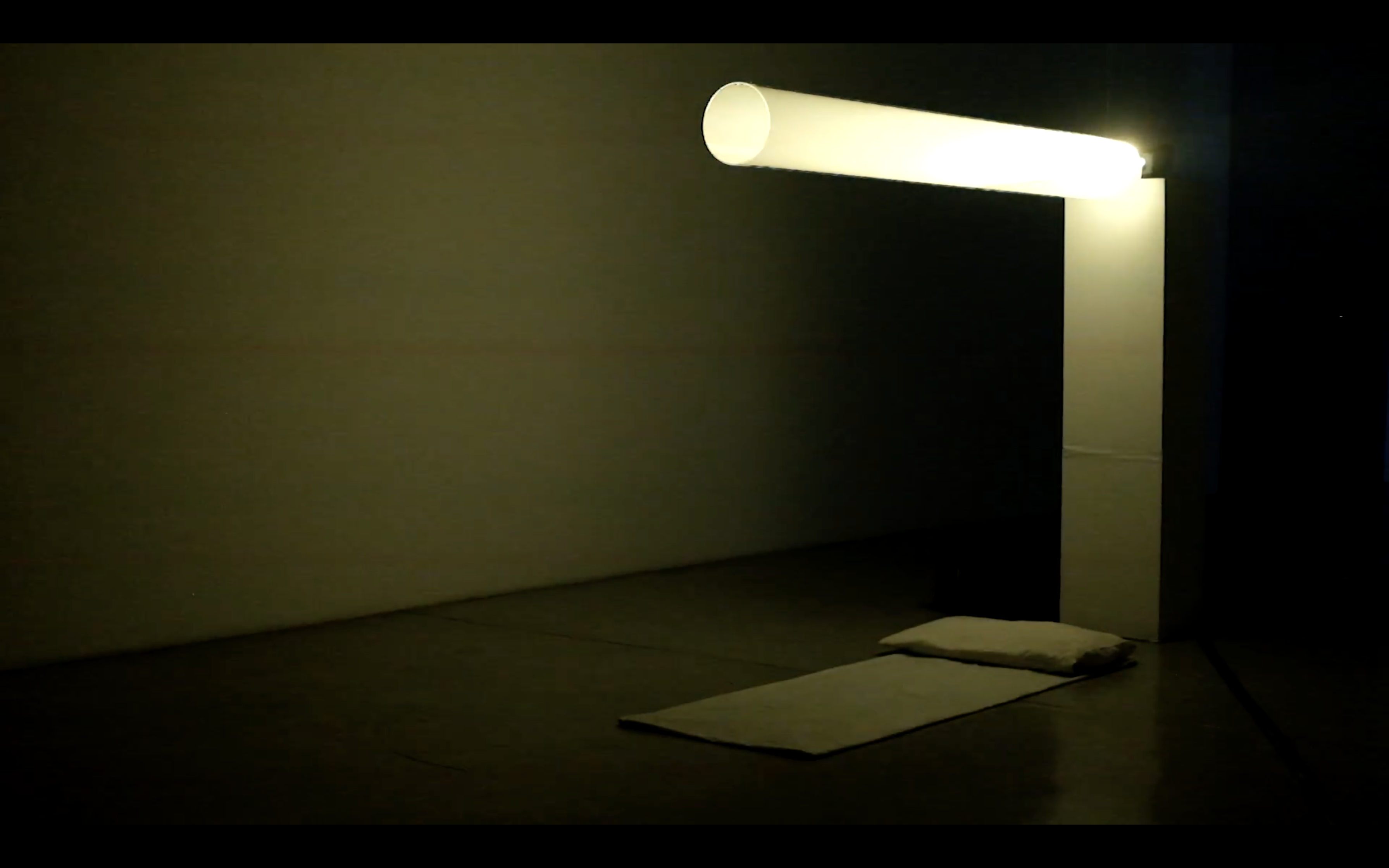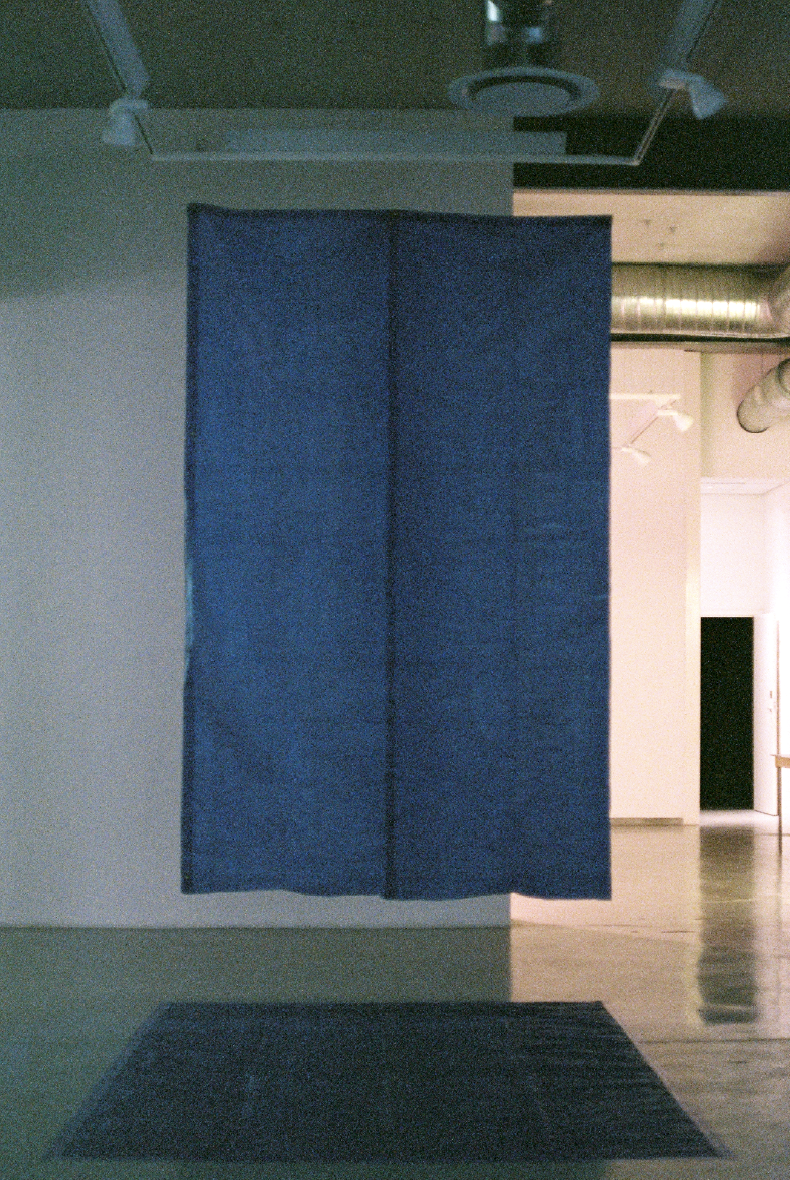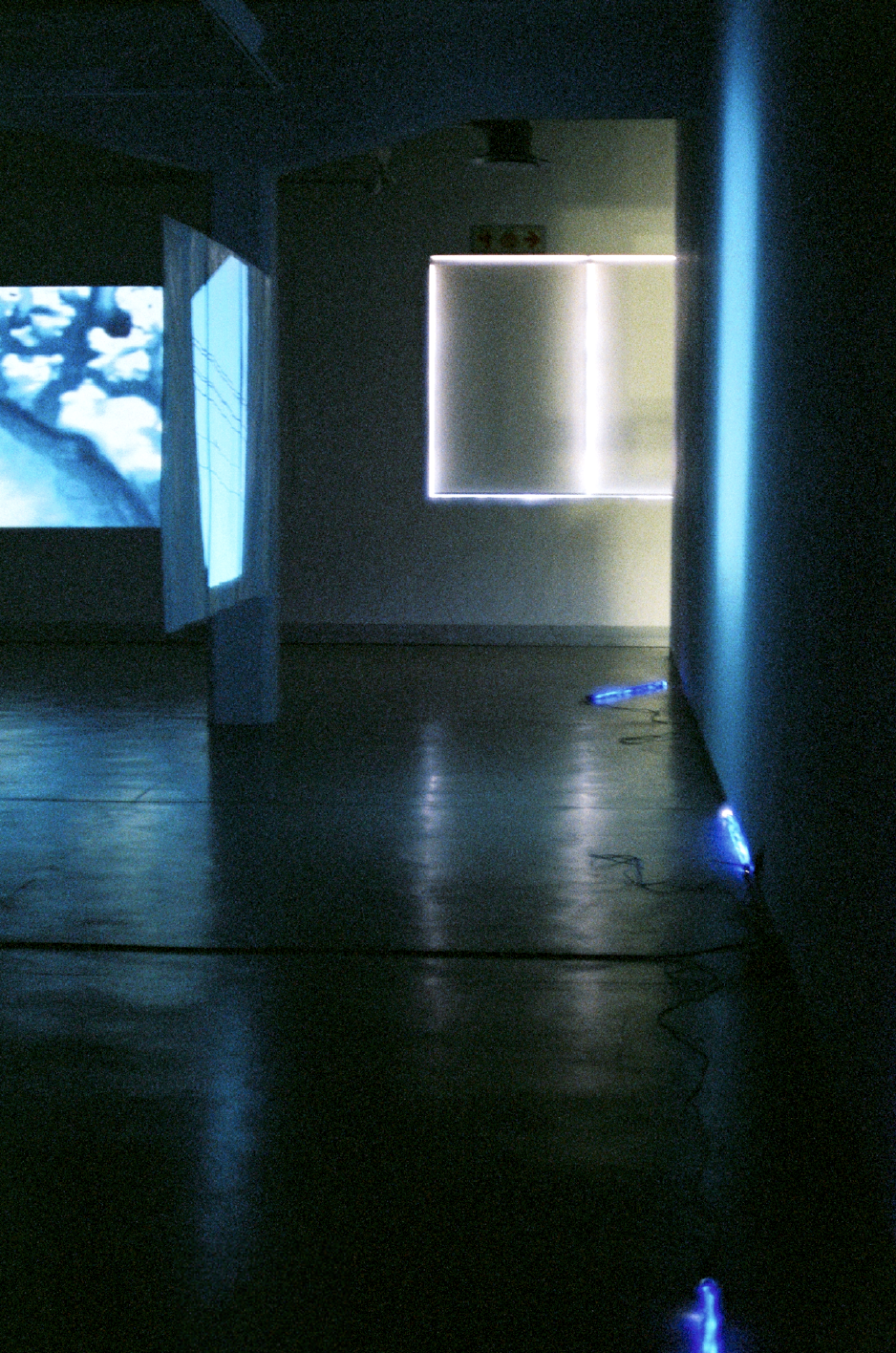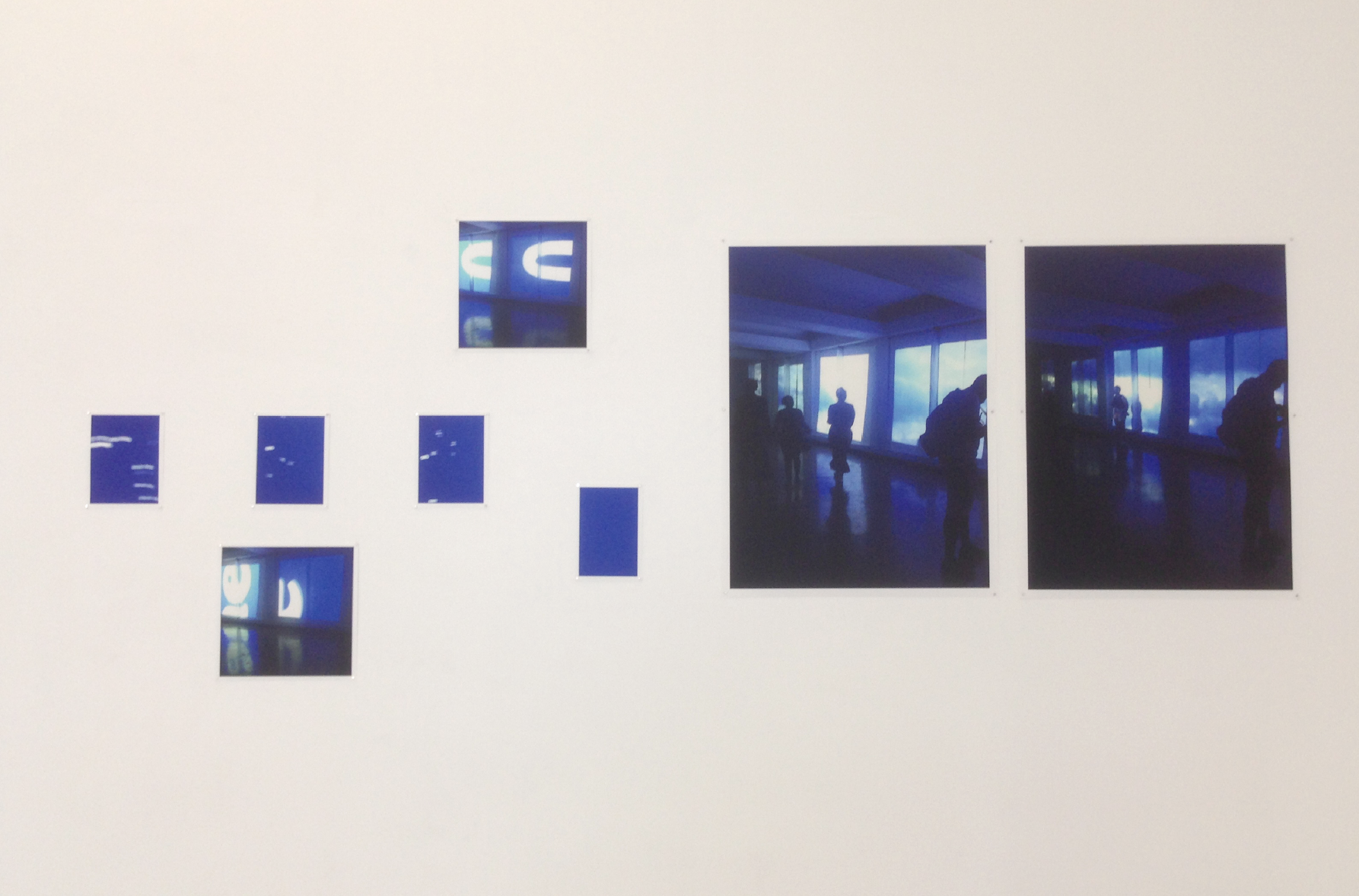Monument
by Riley Pam-Grant, Claire Meekel & Abi Meekel“Monument” is a video, sound and light installation consisting of projected visuals distorted through a tube, transmitting a clear, circular projection onto its adjacent wall. The auditory experience contrasts and layers the obscurity of the visuals by adding a narrative element through field recorded soundscapes. On the floor, beneath the tube lies a small futon-style, single bed on which the audience is encouraged to lie. This format of a video installation challenges the conventions of viewing film. It highlights its physicality through the presence of the objectified tube that exists in the middle of the space. The bed allows for a more personal point of engagement within a public realm wherein the public also views the person viewing, who becomes part of what is being viewed. This speaks to the relationship between public and personal spaces and how one digests transmitted information publicly and privately.
It is in fact the things we find too obvious to talk about and observe, that may give us immense insight into issues of our space and culture, seeing as it’s the routines which seem the most obvious, that we actually understand the most on a deep and unconscious level. “Monument” attempts to bring the unconscious and obvious to the surface through the seemingly alien form of the abstracted visuals in the tube, making the viewer second-guess the obviousness of their naturalised surroundings.
The video, sound and light installation was shown at Gallery MOMO Cape Town in July 2018 as part of the gallery's forth annual video exhibition, Transmissions, and again in Johannesburg where they were invited to show "Monument" in launching the 99 Juta design showrooms space situated in Braamfontein, which is the cultural melting pot of Johannesburg.
![]()
![]()
![]()
![]()
![]()
Jurgen Meekel’s, Palinopsia / seeing again is a laser projection work on a Glow-in-the-Dark (GITD) surface made in collaboration with Jill Richards & BushveldLabs. The 1st try out and première of this digital artwork was shown the ‘Alight block party’ on 1 Sept 2016 in Johannesburg as part of the Fak’ugesi African Digital Innovation Festival. With a purplish-blue UV laser as a projection source and using fully covered painted phosphorescent canvas as the projection surface, I project after-glowing images that appear line by line (much like a fax or inkjet printer). In this way the projection canvas records the image. The projected image/text elements will diminish in luminosity over time. New elements will be projected as the older ones fade. The way temporality and perseverance leave a finite mark or trace of the projected image positions glow-in-the-dark laser projection between cinema and photography.
It is in fact the things we find too obvious to talk about and observe, that may give us immense insight into issues of our space and culture, seeing as it’s the routines which seem the most obvious, that we actually understand the most on a deep and unconscious level. “Monument” attempts to bring the unconscious and obvious to the surface through the seemingly alien form of the abstracted visuals in the tube, making the viewer second-guess the obviousness of their naturalised surroundings.
The video, sound and light installation was shown at Gallery MOMO Cape Town in July 2018 as part of the gallery's forth annual video exhibition, Transmissions, and again in Johannesburg where they were invited to show "Monument" in launching the 99 Juta design showrooms space situated in Braamfontein, which is the cultural melting pot of Johannesburg.





Open Studio: Eeny Meeny Motion Pictures
As part of the developing procedure for Eeny Meeny Motion Pictures, we decided to have an open studio wherein friends, family and strangers could come into a space to test the Augmented Reality web App that we have developed with programmer/game developer, Martijn Patlin. This helped us realise what we need to change; how we can make the viewing experience more interesting and if the software works properly.Assistant to Artist: Jurgen Meekel; Palinopsia/ seeing again
I was an assistant to Audio-Visual Aritist, Jurgen Meekel where I was given the responsibilty to help set-up his installation for two exhibitions and a digital arts festival in South Africa, ISEA. The installation is technically complicated which had its challenges. I documented the processes and explained the work to viewers passing by.Jurgen Meekel’s, Palinopsia / seeing again is a laser projection work on a Glow-in-the-Dark (GITD) surface made in collaboration with Jill Richards & BushveldLabs. The 1st try out and première of this digital artwork was shown the ‘Alight block party’ on 1 Sept 2016 in Johannesburg as part of the Fak’ugesi African Digital Innovation Festival. With a purplish-blue UV laser as a projection source and using fully covered painted phosphorescent canvas as the projection surface, I project after-glowing images that appear line by line (much like a fax or inkjet printer). In this way the projection canvas records the image. The projected image/text elements will diminish in luminosity over time. New elements will be projected as the older ones fade. The way temporality and perseverance leave a finite mark or trace of the projected image positions glow-in-the-dark laser projection between cinema and photography.
The Blue Exhibition i
The Blue Exhibition is a sound, light and video installation which explores semiotics, visual and sonic codes of public communication and engagements in relation to the context it exists in: Johannesburg, South Africa. In exploring signs and symbols and the value of images and sound, The Blue Exhibition attempts to disrupt the contemporary hierarchy of meaning by exploring a new or alternative set of meanings through sound and visuals. This speaks to the idea of an
unfixed and ever evolving meaning in images and the volatile nature of representation and the role technology plays in the re-presentation and reproduction of images, meaning and value. Blue is not the concept but an accessible entry point into exploring the conversation about language and our relationships to visual and sonic codes. It is a simple way of talking about associations, what they mean to us and how they may change.
The first iteration of The Blue Exhibition in 2017 was at a trendsetting club and exhibition space called Glory.
![]()
![]()
![]()
![]()
![]()
![]()
![]()
![]()
![]()
![]()
![]()
![]()
The function of these images to the subject (being the past, present and continuing exhibitions) was to both document the past and stand as its own artistic entity in the present and future, similarly to that of more conventional portraits. In a similar way to which the self portrait is self referential, The Blue Exhibition Portraits are self referential too. By the traditional conventions of portraiture, The Blue Exhibition Portraits would not be considered portraits mainly due to the nature of the subject which overturns most traditional conventions of subjectivity, reference and representation which as said before is focused around the human, and references the existence/presence thereof, and is done so through mimetic representation. However, in the light of the modern conceptions of portraiture, The Blue Exhibition Portraits could be argued to fit and uphold new conventions, or anti-conventions, of the portraits genre particularly in its similarity regarding reference and representation.
Firstly, in the true spirit of modern portraiture, The Blue Exhibition Portraits do not capture the essence of The Blue Exhibition, instead they only depict an aspect or remnant of it, which leads me to the next point of similarity, which is the elusive nature of the subject. The Blue Exhibition Portraits refer not to the presence and fixed nature of the exhibition, but to the past, or better yet, the changing nature of the exhibition and therefore the changing nature of the meaning. It is because The Blue Exhibition Portraits exist as objects of current exhibitions as well documentations or signifiers/icons of past exhibitions that they represent both iconographically and indexically and therefore reference change. The portraits reference a past iteration (a sort of absence), but it is because they exist in the context of a current and new configuration that the comparison between the two is possible and the change and continuity is realised. Much like the case of Boltanski’s re-presented photographs, the subject referred to in The Blue Exhibition Portraits does not correspond with its current reality, which decentralises the importance of “presence” in the portrait and foregrounds the unfixed nature of the subject. (Van Alphen, 1997: 248) Furthermore, uniqueness of the subject is not “captured” in The Blue Exhibition Portraits, but rather realised in comparison to the context of the current exhibition it is based in. Lastly, by the mere fact that these are photographic portraits, they deny the traditional idea of the portrayers subjective originality and as of consequence, the authenticity of the subject, but in the same breath argue the possibility of artistic interference in photography (and technology at large) in the sense that the some of The Blue Exhibition Portraits have been purposefully distorted and push the limits of digital photography which contrasts the idea that photography simply refers. This speaks to the change in form and nature of representation in modern conceptions of portraiture.
![]()
![]()
![]()
![]()
![]()
unfixed and ever evolving meaning in images and the volatile nature of representation and the role technology plays in the re-presentation and reproduction of images, meaning and value. Blue is not the concept but an accessible entry point into exploring the conversation about language and our relationships to visual and sonic codes. It is a simple way of talking about associations, what they mean to us and how they may change.
The first iteration of The Blue Exhibition in 2017 was at a trendsetting club and exhibition space called Glory.




The Blue Exhibition ii
The second iteration of The Blue Exhibition took place at the Fak’ugesi, African Innovation Festival in Braamfontein, Johannesburg. This was a digital arts and music festival of which The Blue Exhibition occupied the first floor of the Shine Studios building. Five projections were projected into five 3 meter square windows viewable from both inside and out. This allowed people to view the work from two different spatial contexts, inside accompanied by our soundscapes and the outside accompanied by the sounds of the city.


The Blue Exhibition iii
The third and the most recent exhibition took place at Gallery MoMo, Cape Town. The exhibition occupied the entire space, being three rooms and a video room.The first room consisted of a new addition to the exhibition: A series of documentative and abstracted photographs of the previous exhibition at Fak’ugesi. The second room consisted of two large projections along with soundscapes that could be heard throughout the entire space. In addition, blue tarpaulin hung from the ceiling, interrupting the space. The third room consisted of two more projections, one of which was projected onto suspended butchers paper central to the space. Blue tube lights were placed along the floor. The video room consisted of a double projection along with the soundscapes which allowed for a more intimate experience of the visuals and sound.






Portraits
The latest iteration of The Blue Exhibition included a photographic aspect titled, “Portraits”. This series of photographs depicted a previous iteration of the exhibition as the subject, some of the photographs of which were abstracted and distorted in the format of a panorama, which in a sense presented the exhibition representatively, and some of which were more documentative in nature.The function of these images to the subject (being the past, present and continuing exhibitions) was to both document the past and stand as its own artistic entity in the present and future, similarly to that of more conventional portraits. In a similar way to which the self portrait is self referential, The Blue Exhibition Portraits are self referential too. By the traditional conventions of portraiture, The Blue Exhibition Portraits would not be considered portraits mainly due to the nature of the subject which overturns most traditional conventions of subjectivity, reference and representation which as said before is focused around the human, and references the existence/presence thereof, and is done so through mimetic representation. However, in the light of the modern conceptions of portraiture, The Blue Exhibition Portraits could be argued to fit and uphold new conventions, or anti-conventions, of the portraits genre particularly in its similarity regarding reference and representation.
Firstly, in the true spirit of modern portraiture, The Blue Exhibition Portraits do not capture the essence of The Blue Exhibition, instead they only depict an aspect or remnant of it, which leads me to the next point of similarity, which is the elusive nature of the subject. The Blue Exhibition Portraits refer not to the presence and fixed nature of the exhibition, but to the past, or better yet, the changing nature of the exhibition and therefore the changing nature of the meaning. It is because The Blue Exhibition Portraits exist as objects of current exhibitions as well documentations or signifiers/icons of past exhibitions that they represent both iconographically and indexically and therefore reference change. The portraits reference a past iteration (a sort of absence), but it is because they exist in the context of a current and new configuration that the comparison between the two is possible and the change and continuity is realised. Much like the case of Boltanski’s re-presented photographs, the subject referred to in The Blue Exhibition Portraits does not correspond with its current reality, which decentralises the importance of “presence” in the portrait and foregrounds the unfixed nature of the subject. (Van Alphen, 1997: 248) Furthermore, uniqueness of the subject is not “captured” in The Blue Exhibition Portraits, but rather realised in comparison to the context of the current exhibition it is based in. Lastly, by the mere fact that these are photographic portraits, they deny the traditional idea of the portrayers subjective originality and as of consequence, the authenticity of the subject, but in the same breath argue the possibility of artistic interference in photography (and technology at large) in the sense that the some of The Blue Exhibition Portraits have been purposefully distorted and push the limits of digital photography which contrasts the idea that photography simply refers. This speaks to the change in form and nature of representation in modern conceptions of portraiture.




